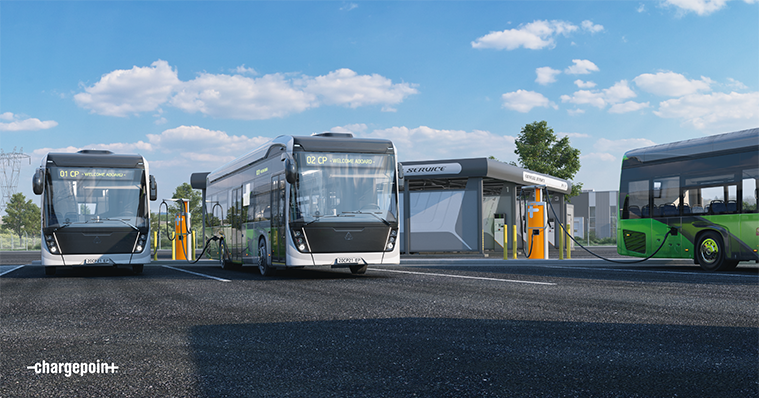
How fleets with complex schedules can realise the full benefits of going electric
It's certain — the future of transportation is electric. Fleets across industries are electrifying and they're doing so fast. Depending on the field of activity, operators have different challenges. For example, fleets with complex schedules, such as those for public transit or last-mile delivery, must not only manage a large pool of vehicles and charging assets but also complete complex route planning with high accuracy. Here's a look at the most common challenges encountered by operators of electric fleets with complex schedules, and what they can do to overcome them.
Accurate range forecasts
When it comes to electric vehicles (EVs), one initial concern of operators is range. Fleets with tight schedules and complex routes need vehicles optimised to meet mission-critical demands, sometimes around the clock. If a vehicle cannot run because the battery is not sufficiently charged, it can disrupt an entire operation — not just a single route. Whether the driver forgot to plug in or the battery itself has an issue, the impact will be felt throughout the entire operation. That particular route will need to be completed regardless, and now the fleet operator must manage delays, find an alternate vehicle and often an extra driver.
Having access to information such as accurate range forecasts, live vehicle status and location details, unnecessary idling data and charger status is essential for a smooth operation. Using advanced fleet management solutions helps operators manage their fleet using accurate data on vehicles, routes and chargers. Operators are in full control with real-time visibility into vehicle location, remaining battery range and which chargers are available. They can also identify timely vehicle and charger issues that might otherwise affect the overall planning.
Preconditioning vehicles to start their service with a full battery and maximum remaining range is another way to optimise vehicle time on the road and provide peace of mind.
Another aspect to consider is that the energy consumption of EVs is more sensitive to weather and road conditions than vehicles fuelled by diesel. In addition, because of the current battery size and energy storage limitations, driving style can also impact range. That's why it's important to have insights into driver behavior. Driving as smoothly as possible and minimising harsh acceleration or harsh braking supports maximum operational range and helps maintain overall battery health.

Multi-asset management
Transitioning to an e-fleet usually means managing vehicles from various automakers (OEMs), with different propulsion systems (such as diesel, electric and hybrid). In addition, electric and hybrid vehicles may use both depot and on-route chargers, also from various manufacturers. Fleets with complex schedules tend to be large, meaning you'll have many assets to manage. If each vehicle and each charger comes with its own proprietary software solution, you'll then need to learn, manage, monitor, maintain and integrate multiple software platforms.
To say the least, this scenario can become difficult to manage, very quickly.
If multiple IT systems function in silos, data cannot easily be shared with your existing or future IT systems. Having the ability to exchange data between your IT systems will ultimately unlock the full potential of your e-fleet.
That's why having fully integrated software solutions —from planning and operations to charging process management —that can communicate openly with each other within your IT environment will be key to the success of your fleet electrification.
Cost efficiency
Electric fleets with complex schedules have many benefits over diesel fleets, including a lower total cost of ownership (TCO). Nevertheless, the initial investment of electrification can be capital intensive. Old vehicles need to be replaced with electric ones, which imply a high upfront cost. Charging infrastructure must also be put in place, and depots must be upgraded.
When it comes to cost efficiency, there are three main areas of concern: charging costs, minimising consumption and protecting the batteries.
Charging costs
Charging many electric vehicles, each with its own schedule, can be logistically challenging, as it requires high-power grid connections and an extensive infrastructure. Usually, more than one vehicle needs to charge at the same time, putting pressure on the power grid. Grid limitations and peak power loads can also raise the electricity bill significantly.
Networked charging processes allow operators to monitor and manage charging sessions, which means they can remotely control when, for how long and how fast a vehicle charges. These solutions help by increasing the efficiency of the charging infrastructure and decreasing energy costs.

Minimising consumption
The efficiency of electric fleet operations depends on more than just the right vehicles and infrastructure. Driving style has a significant impact on consumption, especially when the vehicles are running on a tight schedule and the drivers need to make sure they reach all destinations on time.
Driving style can be hard to influence —that is, without data. Luckily, technology can help. For example, Smart Driving, from ViriCiti (now part of ChargePoint), shows operators how drivers are handling their vehicles and what aspects they can improve. The software is designed with transparency and fairness in mind, for both drivers and operators —it only considers the drivers’ influence on the trips, while external factors like weather and vehicle load are excluded. The transparent data guides operators in training drivers in order to reduce costs directly related to idling and driving style, and to increase safety and passenger comfort.
Protecting battery health
In general, the most expensive part of an electric vehicle is the battery. For large EVs, the battery alone can represent up to 50% of the total cost of the vehicle, whereas on average, the battery costs amount to approximately one-third of the total cost of battery-electric vehicles (BEVs). As in the EV world, it’s customary to no longer use a battery when it reaches 80% of its original capacity, it’s even more significant to look at battery health. Understanding how batteries are performing allows operators to detect and fix battery issues faster by collecting field data remotely. Battery health monitoring tools therefore directly help operators protect their investment and ensure a long-term cost amortisation.
Do you want to further optimise your e-fleet? Our EV experts are available to help you find a solution that fits your specific needs.

